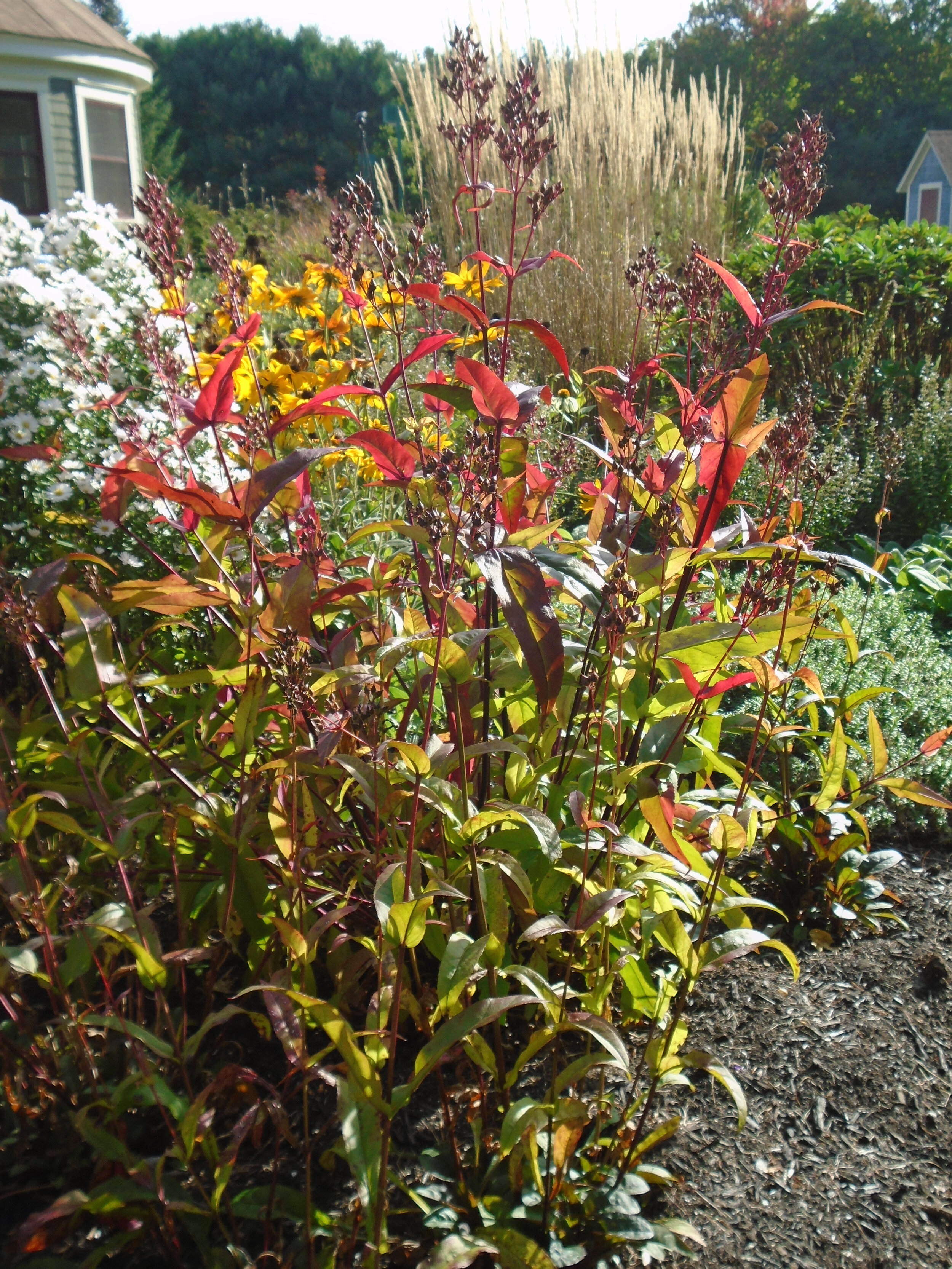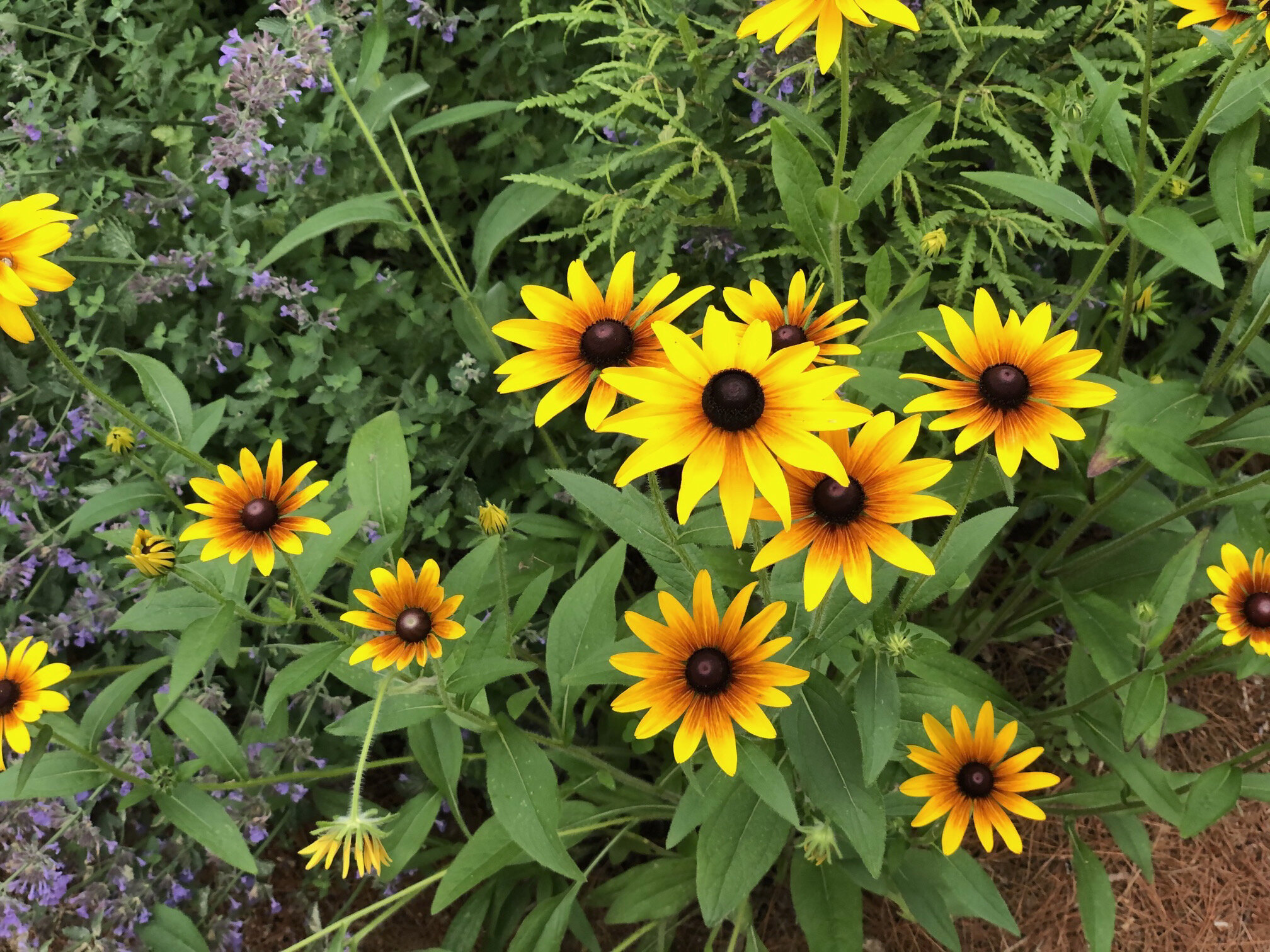Favorite garden plants for mid-coast Maine
Actea racemosa (bugbane, black cohosh or snakeroot)
Wonderful architectural native plant, attracting a variety of pollinators. Strongly scented. Blooms in July. Prefers moist soils; may need staking, especially in drier sites.
Allium spp. (ornamental onion)
Related to chives, these little gems look good all season - with lovely foliage, followed by beautiful buds which stay on the plants for over a month before exploding into long-lasting purple flowers, beloved by bees.
Amsonia hubrictii (Arkansas bluestar)
Native to the southern US, this beautiful plant has lovely blue flowers in spring, provides great texture all season, and turns stunning shades of yellow and orange in fall. Eastern bluestar (Amsonia tabernaemontana), also native to the southern US, is another wonderful garden plant.
Anemone blanda (windflower)
Exuberant daisy-like blooms in spring. Terrific for planting under shrubs. Foliage dies to the ground in summer. Will spread happily over time to form colonies. Grows from small corms (similar to a bulb).
Asclepias tuberosa (butterfly weed)
Along with other plants in the milkweed family (genus Asclepias), this is one of the only food sources for Monarch butterfly caterpillars. Monarchs are rapidly declining in number, partly due to loss of habitat for milkweeds. I love butterfly weed for its brilliant orange color. It puts on a long-lasting dazzling display in June and then continues with sporadic flowering until September. It spreads by deep underground runners so use a little caution in deciding where to plant.
Baptisia australis (false indigo)
Dramatic in bloom, then forms interesting brown seed pods. This plant is a nitrogen-fixer which means it is able to take nitrogen out of the air and make it available to plants. Very long-lived; does not transplant well. Native to the southeast US.
Clethra alnifolia (summersweet)
Native to New England, this shrub blooms in summer, with very fragrant blossoms attractive to a range of native pollinators. Prefers moist sites, but tolerant of a wide range. Pictured is ‘Pink Spice;’ however most varieties, including the straight species, are white.
Comptonia peregrina (sweetfern)
Tough-as-nails native plant related to bayberry, not to ferns. Tolerates poor soil, wet soil and drought; prefers dry sandy sites. Nitrogen-fixer. Used by native Americans to treat poison ivy. Reported to repel mosquitoes. Makes a nice tea. Smells divine as you stroll by. Can spread by long roots when happy, so be careful where you use it.
Cornus sericea (red twig dogwood)
A great native plant with attractive flowers in spring followed by dark berries in fall. Supports native birds and pollinators. Widely grown for lovely red stems over winter, especially on younger branches.
Echinacea spp. (coneflower)
One of the best for long bloom and drought tolerance. Don’t cut the flower heads back in the fall and songbirds will show up to nibble on the seeds into winter, and even spring if there is anything left standing. Goldfinches especially love them. The basic purple or white varieties are generally much tougher than the newer colors... but the new colors are fun to try! Medicinal uses.
Eschscholzia californica (California poppy)
I have been in love with this plant since I was a child and found it growing in a crack in the sidewalk in the city with no other poppies nearby. It's an annual that self-seeds very happily in any well-drained, average to lean soil.
Eupatorium purpureum & other species (Joe pye weed)
I fear this bee-magnet may be the plant that finally caused my neighbor to erect a fence. This plant loves moisture, but will grow fairly well in decent soil (to over 7’ in my garden) without any supplemental water. Some Eupatorium are native to Maine.
Fothergilla major & gardenii
Great shrubs, with 3-season interest, native to the southeastern U.S. Many with lovely bluish leaves, fragrant spring blooms and dramatic fall color. Full sun to part shade.
Gillenia trifoliata (Bowman’s root)
Native to the east coast (range starts just south of New England). Small dancing airy white flowers, lovely massed.
Helenium spp. (Helen's flower, sneezeweed)
Excellent plant for a very long season of bloom. Needs moist and/or heavy soil. Can be cut back hard in early July for shorter, later blooms that are less likely to flop. Many good varieties; I'm partial to 'Mardi Gras' and 'Wyndley.'
Hemerocallis spp. (daylily)
These exuberant plants will tolerate almost anything and still look lush and beautiful. Remarkably free of pest problems, endless choice of color and height. The old-fashioned orange ones (H. fulva) are edible (leaves, blossoms, roots, & buds) but this may not be true for other varieties and cultivars. Make sure you know what you are harvesting and how to prepare it. And yes, each blossom is open for just one day.
Lathyrus vernus (spring bush pea)
Gorgeous bright flowers by mid-May. Nitrogen fixer.
Liatris spicata (Gayfeather, Blazing star)
Liatris is a superb vertical accent in the garden. It is readily available in white and purple forms. In my garden this plant attracts more butterflies than any other. It is also more drought-tolerant than most books give it credit for. US native.
Monarda (bee balm)
Monarda didyma (pictured far left) is the plant that brings in the hummingbirds. Can spread aggressively by surface rhizomes, so plant with care. Several other Monardas are native to New England and make wonderful garden plants: M. fistulosa, M. braburiana, and M. punctata (pictured left) are all good plants.
Nepeta faassenii 'Blue Wonder' (catmint)
An amazing plant that blooms for most of the summer and is always covered by bees. Very drought tolerant. Can grow to 6' in diameter in a few seasons if happy.
Penstemon digitalis (Beardtounge)
Small white flowers attractive to hummingbirds and pollinators, native to the US. Dark-leaved varieties such as ‘Husker’s Red’ are lovely in the fall.
Phlox divaricata (Woodland phlox)
Native, early, pollinator attractor, spreads happily in dappled shade. Excellent under shrubs.
Phlox subulata (moss phlox)
Another great phlox, native to the mid-Atlantic states. Does well in hot, dry areas. ‘Emerald Blue’ is a favorite (pictured left with basket-of-gold).
Polgonatum spp. (Solomon's seal)
Elegant shade plant. Prefers medium to wet soil, but will thrive in dry shade if the soil is rich.They are beautiful coming up in spring. Some species are native and some are edible; please research correct harvesting and cooking practices.
Rudbeckia hirta (black-eyed susan)
I love most black-eyed susans, but this species is more drought-tolerant and tough than some of the others. Relatively short-lived plant, but a happy self-seeder. Different varieties will cross with each other and give you new surprises every plant. Native to New England.
Rudbeckia nitida ‘Herbstsonne’ (black-eyed susan)
Native, beloved by pollinators and birds. Leave flower stalks standing all winter and enjoy goldfinches through the fall and again in spring.
Salvia officianalis (edible sage)
Looks (and smells) great all season. Bees adore.
Sedum spp.
Nothing beats a sedum for looking good all season. As over-used as it is the ‘Autumn Joy’ cultivar is still a great plant. I’m also fond of the purply leaves & stems of ‘Maestro,’ pictured here, though it’s not nearly as long-lasting.
Stachys byzantina 'Big Ears' (lamb's ear)
A favorite for edging beds and walkways as it loves the hot, dry location. It manages to look lush and vigorous in these difficult spots. Requires well drained soil and dislikes moisture on its leaves.
Symphyotrichum oblongifolius (aromatic aster)
One of the last things to bloom in the garden. Native to the US. ‘October Skies’ is a great variety, covered in clouds of blue (and pollinators) into October.
Tiarella cordifolia (foamflower)
A native spreading groundcover that blooms in early spring. These tiny elegant spires of white are surely the lanterns for gatherings of fairies and other forest folk.
Vaccinium corymbosum (highbush blueberry)
What’s not to love? These are one of the best plants for supporting local birds and insects (because of the berries, because of the caterpillars that eat the leaves and then feed the birds, and because of value to pollinators). They also provides amazing fruit and have glorious fall color. They can be tricky to establish, requiring good drainage, hi-acid soils with high organic matter (do a soil test), and adequate water through the season. They may also take some years to settle in and start thriving.
Viola tricolor (Johnny jump-ups)
Common European wildflower. I love the high degree of color variability among seedlings; you never know what you will get. Rambunctious self-seeder, but easy to pull. Edible flowers look great in salads. Flower buds and young leaves can be used to thicken soups. My mom used to lie in the fields in Denmark and talk to them.
Sarah Wolpow * (207) 721-0941 * SweetFernGarden@comcast.net * Brunswick, ME 04011












